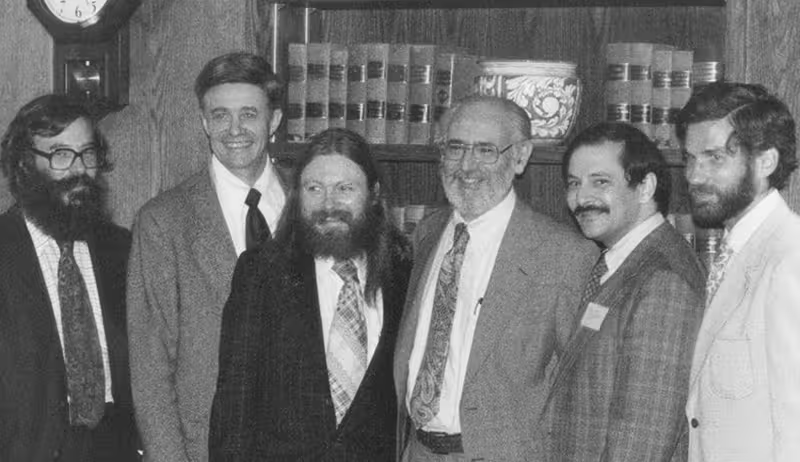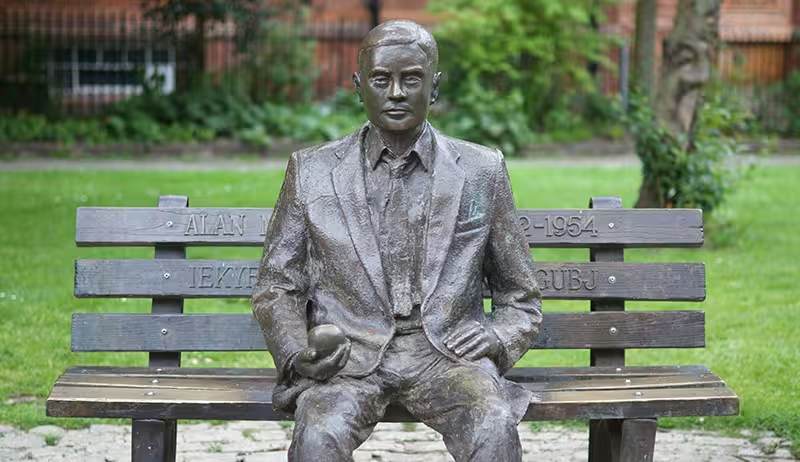Who was Kenneth E. Iverson?

In the winter of 1920, Kenneth Eugene Iverson was born just outside the small town of Camrose in Alberta, Canada. At the height of the Great Depression he dropped out of school after just Grade 9 (aged 11) to work on the family farm. Despite his modest upbringing, Iverson eventually found himself at Harvard University , working on a revolutionary mathematical notation. This pioneering effort would become his life’s work: the programming language APL.

Early Life
While working the farm and still out of school, Iverson self-studied calculus from a textbook. He chose not to return to school, however, because at the time he thought that further schooling would only lead to a career path as a schoolteacher.
In 1942, at the age of 22, Ken Iverson was drafted into the Canadian Forces; a year later he had transferred to the Royal Canadian Air Force. While in the military, he enrolled in correspondence courses offered by the Canadian Legion towards finishing his high school diploma.
After his discharge in 1946, at the behest of both counsellors and fellow servicemen, Iverson enrolled as an undergraduate at Queen’s University in Kingston, Ontario, Canada. Iverson graduated the top of his class in 1950, with a Bachelor’s degree in mathematics and physics.
Birth of the Notation
Upon graduating from Queen’s, Iverson continued his education at Harvard University in Boston, Massachusetts, in the United States. Within his first year there, he had earned a Masters degree in mathematics. Following this, he entered the Department of Engineering and Applied Physics after taking a class taught by physicist Howard Aiken . His Ph.D. thesis was supervised by Aiken and economist Wassily Leontief .
Ken Iverson stayed at Harvard as an assistant professor, and was tasked with developing a course in Business Data Processing. He was “appalled” to find that conventional mathematical notation became inconsistent when describing operations on matrices and higher dimension arrays, and he developed a mathematical notation (Iverson Notation) that was concise and consistent for those purposes – and for teaching data processing.


Career at IBM
Iverson joined IBM in 1960, where he continued to develop and promote his notation. He published a book, A Programming Language, describing the notation developed at Harvard.
Because of its conciseness and consistency, the notation inspired an implementation as an executable language on the IBM 360 system. This implementation was called APL\360. It became available inside IBM in 1966 and outside IBM in 1968, where it found widespread use across the world at universities and in business.
His work at IBM included projects that demonstrated APL’s capabilities in system software, education, and data analysis.
Career at I. P. Sharp Associates
Iverson left IBM in 1980 to join I. P. Sharp Associates, an APL time-sharing business. Here he continued his work on simplifying and extending APL, resulting in the publication of Rationalized APL in 1983, which rationalised the use of functions and operators in APL, and multiple versions of A Dictionary of APL.
Ken Iverson retired from I. P. Sharp in 1987.


The J Programming Language
Retired but still active, Ken continued to work on APL. He had always been heavily invested in education, and he felt that there was a need for a shareware version of APL. He also wanted to address the common problems of handling the symbols used in APL.
The result was J , based on the Dictionary APL with some additions, and implemented in C by Roger Hui , with inspiration from Arthur Whitney . It was presented at the international APL conference in 1990.
Ken Iverson continued working on J until the end of his life.
Awards and Legacy

Birth
Education
War Service
Graduate Studies
Doctorate
Early Career
APL Development
A Programming Language
IBM Career
Turing Award
I. P. Sharp Associates
Retirement
J Software
Death
The Origins of APL - 1974
Insights from Ken Iverson and other Pioneers
A glimpse into the fascinating history of APL. This classic 1974 video features Ken Iverson, the creator of APL, along with other pioneering figures. Discover the vision behind APL, its applications, and the perspectives of those who contributed to its creation and development.

Featured in the video are: Ken Iverson : The creator of APL, whose innovative ideas and notation formed the foundation of the language. Philip S. Abrams : One of the original developers who contributed significantly to the early implementations of APL. Larry Breed : A pioneering developer involved in APL’s creation and its applications. Adin Falkoff : Known for his collaboration with Iverson, helping to refine and extend the language. Roger Moore : Another early contributor to APL’s development.
